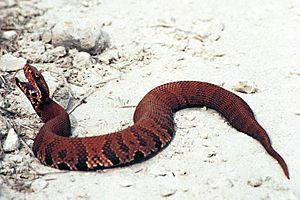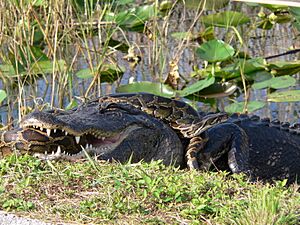List of snakes of Florida facts for kids
Florida is a warm, sunny state in the United States, and it's home to many different kinds of snakes! Some snakes are harmless and help keep the environment healthy, while others are venomous and can be dangerous if you get too close. It's important to learn about these amazing creatures so you can appreciate them and know how to stay safe. This list will tell you about some of the snakes you might find slithering around Florida.
Contents
Non-Venomous Snakes
Most snakes in Florida are not venomous, meaning they don't have poison that can hurt humans. These snakes are very important for the environment because they help control pests like mice and rats. They are often shy and will try to avoid people.
Black Racers
Black Racers are fast, slender snakes that are usually black. They are very active during the day and can often be seen zipping across roads or through yards. They eat small animals like frogs, lizards, and rodents.
- Southern Black Racer
Coachwhips
Coachwhips are long, thin snakes known for their speed. They get their name because their body looks a bit like a braided whip. They are excellent hunters and eat lizards, birds, and even other snakes.
- Eastern Coachwhip
Red Belly Snakes
These small, shy snakes are often found hiding under rocks or logs. They are usually brown or gray on top and have a bright red or orange belly. They mostly eat slugs and earthworms.
- Florida Brown Snake
- Florida Redbelly Snake
Crayfish Snakes
Crayfish snakes love to live near water, like swamps and marshes. As their name suggests, they mainly eat crayfish! They are good swimmers and spend a lot of time searching for food in the water.
- Glossy Crayfish Snake
- Striped Crayfish Snake
Crowned Snakes
Crowned snakes are small and slender, usually with a dark head that looks like a "crown" against their lighter body. They are secretive and spend most of their time underground or under leaf litter, hunting for small invertebrates.
- Southeastern Crown Snake
Garter Snakes
Garter snakes are common and can be found in many different habitats, from forests to suburban gardens. They often have stripes running down their bodies. They eat a variety of small prey, including worms, frogs, and fish.
- Eastern Garter Snake
- Southern Ribbon Snake
- Bluestripe Garter Snake
Green Snakes
Green snakes are bright green, which helps them blend in perfectly with the leaves and branches where they live. They are very thin and mostly eat insects like crickets and grasshoppers.
- Rough Green Snake
Hognose Snakes
Hognose snakes have a unique, upturned snout that they use to dig in the dirt. When threatened, they often put on a dramatic show, hissing loudly and even playing dead! They are not venomous and mostly eat toads.
- Eastern Hognose Snake
- Southern Hognose Snake
Indigo Snakes
The Eastern Indigo Snake is one of the longest snakes in North America and is a beautiful shiny black. It is a protected species in Florida. These snakes are not venomous and eat a wide range of animals, including other snakes (even venomous ones!).
- Eastern Indigo Snake
Kingsnakes
Kingsnakes are known for their beautiful patterns and for eating other snakes, including venomous ones, as they are immune to their venom. They are constrictors, meaning they squeeze their prey.
- Florida Kingsnake
- Mole Kingsnake
- Scarlet Kingsnake
- Short-tailed Snake
Rainbow Snakes
Rainbow snakes are stunning, with iridescent scales that shimmer in the light, giving them a "rainbow" effect. They live near water and are excellent swimmers, feeding mostly on eels.
- Eastern Mud Snake
- Rainbow Snake
Pine Snakes
Pine snakes are large, powerful constrictors that live in pine forests. They are known for their loud hiss when disturbed. They mostly eat rodents, birds, and their eggs.
- Black Pine Snake
- Florida Pine Snake
Pine Woods Snake
This small, secretive snake is found in pine forests, often hiding under bark or logs. It's not very common to see them because of their hidden lifestyle.
- Pine Woods Snake
Rat Snakes
Rat snakes are common throughout Florida and are excellent climbers. They are very helpful to humans because they eat a lot of rodents, which helps control pest populations.
- Gray Rat Snake
- Red Rat Snake (Corn Snake)
- Eastern Rat Snake (Yellow Rat Snake)
Ring-necked Snakes
These small, slender snakes are easily recognized by the bright yellow or orange ring around their neck. They are usually dark gray or black on top and have a bright belly. They are secretive and eat small invertebrates.
- Southern Ring-necked Snake
Scarlet Snakes
Scarlet snakes are beautiful, with bright red, black, and yellow bands that can sometimes make them look like venomous coral snakes. However, they are harmless and eat reptile eggs and small lizards.
- Scarlet Snake
Water Snakes
Water snakes are common near ponds, lakes, and rivers. They are good swimmers and often bask in the sun on branches overhanging the water. They mainly eat fish and amphibians.
- Brown Watersnake
- Florida Banded Watersnake
- Red-Bellied Watersnake
- Florida Green Water Snake
- Salt Marsh Snake
- Mangrove Salt Marsh Snake
- Atlantic Salt Marsh Snake
Venomous Snakes
Florida is also home to several types of venomous snakes. These snakes have special fangs that deliver venom (poison) when they bite. It's very important to know how to identify these snakes and to keep a safe distance from them. If you see a venomous snake, do not approach it.
Pit Vipers
Pit vipers get their name from the heat-sensing "pits" on their faces, which help them find warm-blooded prey in the dark. They have triangular heads and thick bodies.
- Florida Cottonmouth: Also known as a water moccasin, this snake is found near water. It may open its mouth to show a white, cotton-like lining as a warning.
- Southern Copperhead: These snakes have distinctive hourglass-shaped patterns on their bodies. They are usually found in wooded areas.
- Eastern Diamondback Rattlesnake: This is the largest venomous snake in North America. It has diamond-shaped patterns and a rattle on its tail that it shakes to warn off threats.
- Timber Rattlesnake (Canebrake Rattlesnake): Another large rattlesnake, often found in forests. It also has a rattle and can be quite long.
- Dusky Pygmy Rattlesnake: This is a small rattlesnake with a tiny rattle that sounds like a buzzing insect. It's often found in pine forests.
Elapid
Elapids are a group of venomous snakes that include cobras and mambas. In Florida, the only native elapid is the coral snake.
- Eastern Coral Snake: These snakes have bright red, yellow, and black bands. They are often confused with harmless scarlet snakes. Remember the rhyme: "Red touch yellow, kill a fellow; red touch black, venom lack" to tell them apart. Coral snakes are shy and rarely bite unless provoked.
See also
- List of amphibians of Florida
- List of birds of Florida
- List of mammals of Florida
- List of reptiles of Florida
- List of fishes of Florida
- List of invasive species in Florida
- List of invasive species in the Everglades
- Fauna of Florida



